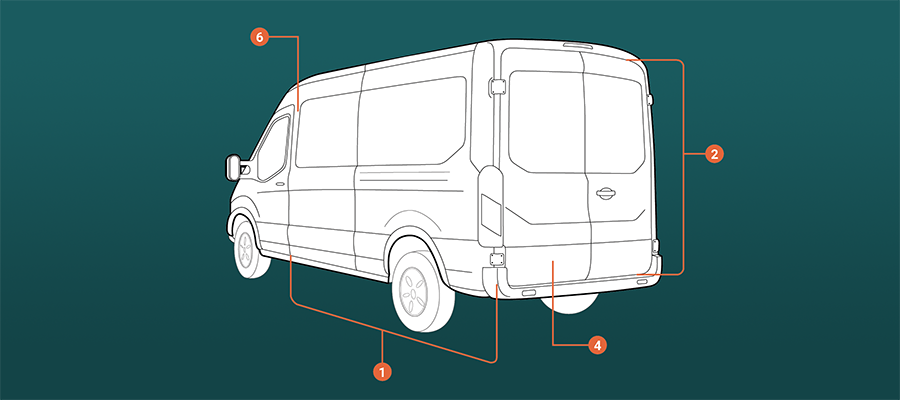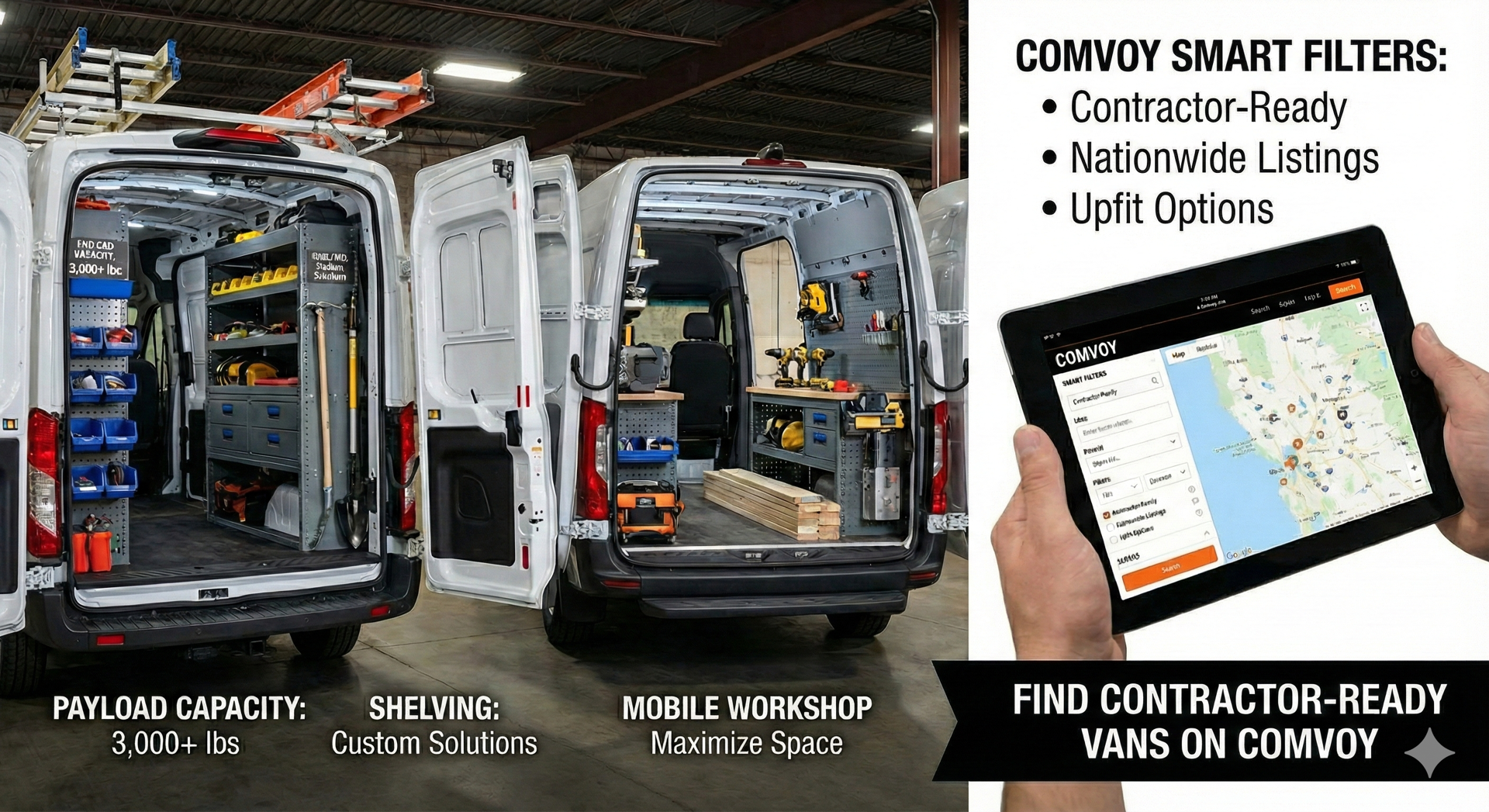Cargo Van: Your Business Safely Stowed


Cargo Van: Your Business Safely Stowed
Cargo vans are the perfect middle ground between a work truck and a box truck, with all of the maneuverability a work truck provides and the added security of an enclosed cargo hold for valuable products and materials. Whether you’re a tradesman hauling tools and supplies or a light delivery business, commercial vans such as the Mercedes Benz Sprinter, Ford Transit, Ford E-Series, and Ram ProMaster offer excellent capacity and customization in a secure, organized space.
Benefits of Cargo Vans
Cargo vans offer numerous benefits for businesses, contractors, and professionals who transport goods, tools, and equipment. One of the main benefits is the boost in productivity that they offer. With ample cargo space, businesses can transport more goods and equipment in a single trip, boosting efficiency and reducing the number of trips needed.
Cost-effectiveness is another major advantage. Cargo vans typically have a lower cost per mile than larger commercial vehicles, making them an economical choice for businesses that frequently transport goods and equipment but don’t need a full-sized box truck. Their fuel-efficient design adds to the savings by lowering overall operational expenses.
Cargo vans are known for their versatility. They come in a variety of configurations, including multiple roof heights, wheelbase options, and engine types, allowing them to meet your specific business requirements. Whether you need a small cargo van for city deliveries or a full-size cargo van for larger loads, there’s a model to fit your needs.
Another standout advantage is their ease of customization. Cargo vans can be outfitted with features like shelving, storage compartments, and refrigeration units to align with your specific business needs. This level of personalization transforms the van’s interior into an organized and highly efficient workspace, making it a valuable tool for any operation.
Secure cargo storage is another critical aspect. Cargo vans are designed with lockin
g doors and cargo tie-downs to prevent theft and damage. These features ensure that valuable goods and equipment are safely stowed during transit, providing peace of mind for business owners.

Wheelbase
When considering wheelbase length, it is important to note what you’ll be hauling in the back of your van and the daily routes your crew takes. Basically, a shorter wheelbase van will manage marginally less cargo space but maneuver tight city streets far easier than a long-wheelbase model. On the other hand, a longer wheelbase van will take more real estate to maneuver but will provide more cargo space. Most OEMs offer multiple length options; for instance, the Ford Transit comes in 115” up to 148”, and the GMC Savana can be had in 135” to 155” options.
Cargo Floor Length
Cargo van owners know that matching cargo capacity to the size of the materials to be transported is the first consideration when purchasing a work van. Cargo vans come in many different lengths depending on what your operation needs. Typical lengths start around 120” and will increase alongside the van’s wheelbase length.
Roof Height
Cargo vans come in many configurations, with manufacturers releasing their models in varying roof heights to suit the needs of each operation. Available in low, medium, and high-roof options, cargo vans offer business owners and fleet managers options to match the vehicle to the intended use case.
Click Here for More Information
Door Options
Cargo van door options are basically limited to the side entry; you can choose either a sliding door or a barn door. Each has its pros and cons.
Sliding side doors are optimal for the crew operating in tight spaces and offer an easy-to-open entry point unhampered by parking lots and side streets.
On the other hand, barn doors have fewer parts to fail, are not affected by as much by adjacent body damage, and you can hang gear on the interior, such as cables and hard hats.
As for the rear doors, some manufacturers produce doors that can open up to 180 degrees or more, offering improved ingress and egress for bulkier items.
Storage / Organization
The most notable aspect of the cargo van is the means of customization in storage. The cargo van is a blank canvas capable of supporting almost any upfit. The interior can be fitted with nearly endless variations of shelving, hooks, cabinets, compartments, tie-downs, and countertops. In addition to the solid build of these upfits, most cargo vans support a welded build for the shelving and compartment frames, providing a secure attachment capable of withstanding hard stops and poor road conditions.

Partitions
A cargo van’s partition is an absolute must if you’re after a safe solution to the possibility of materials shifting throughout the cargo bay. For instance, the Mercedes-Benz Sprinter and Ram Promaster offer various partition options that cater to different business needs. Partition manufacturers and upfitters specify each partition by vehicle and fit them just behind the driver and passenger seats of the cab. Modern partitions can also be ordered with a slight angle, enabling your crew to adjust their driver and passenger seats with limited restrictions. These partitions come in various materials like steel, aluminum, and thermoformed fiberglass.
Though steel and aluminum options are quite popular among tradesmen of all walks, the thermoformed options provide a further secured system. The thermoformed partitions provide a barrier between the cab and cargo bay, and they can also fully seal the barrier, protecting your crew against chemical spills and harmful byproducts of loose material.
Perhaps one of the most useful of these options is the partition doorway. The door is installed on the center of the secured, non-angled partition and offers easy access to the cargo bay during transport. Though the doorway proves useful in its accessible nature, the door is installed on a straight partition which may reduce the reclining angle of cab seating.

Interior
The sky, or windshield if you prefer, is the limit in the interior of a cargo van. While most models offer a two-seat configuration, a cargo van can seat up to five members of your team at one time. Whether you’re looking for a two-seater or capacity for more, manufacturers build their interiors with the notion of “mobile office” in mind. The extensive space between both driver and passenger can support a variety of interior console storage options with added security measures. The focus on function outside of the cargo bay adds utility in taking your cargo van from hauling materials to becoming the premier mobile office.
Cargo Van Seating Option
While most cargo van models come in a two-seat configuration, some can be had in a crew-van variation that provides seating for five.
Cargo Van Safety
Like all commercial vehicles, safety is paramount for cargo vans. Modern cargo vans have advanced safety features designed to protect both the driver and the cargo. Features such as backup cameras, blind-spot alerts, and lane-keeping assist in preventing accidents and ensuring a safer driving experience.
UPDATED ON: JANUARY 10, 2025
Published on: January 01, 2019 Best Work Vans for Contractors
Best Work Vans for Contractors Best Gifts for Truck Drivers and Truck Owners (2025 Guide)
Best Gifts for Truck Drivers and Truck Owners (2025 Guide) 2026 Commercial Trucks and Vans: What’s New from Ford, GM, and Ram
2026 Commercial Trucks and Vans: What’s New from Ford, GM, and Ram The Value of Work Ethic: Comvoy.com Promotes Mike Rowe's Work Ethic Scholarship Program
The Value of Work Ethic: Comvoy.com Promotes Mike Rowe's Work Ethic Scholarship Program Trump's 25% Trucking Tariffs: The Devil is in the Details
Trump's 25% Trucking Tariffs: The Devil is in the Details








